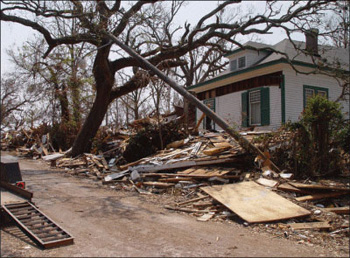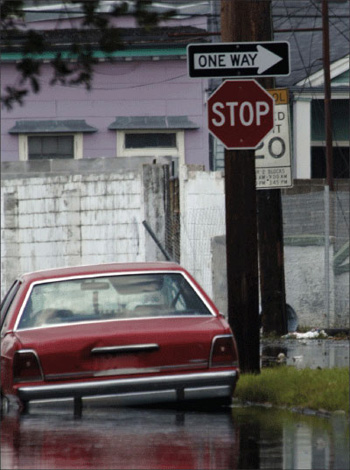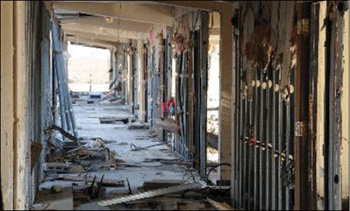Most likely, by way of our television sets, we have all witnessed the unbelievable destruction and devastating consequences of one or another natural disaster. Certainly, hurricane Katrina and the December 26, 2004, Indian Ocean tsunami come to mind. For sure, many of you may also have been personally involved and will have a never-ending memory of the experience.
My personal experience with a natural disaster occurred when a hurricane-type storm struck the area where my family and I reside. We had no major damage, but we were without power for four days on that occasion. Inconvenient? Yes, but we considered ourselves blessed compared to others in the surrounding area who received considerably more damage, which required major renovations to their homes. Things got back to normal quickly, however. A few years back, relatives of ours were severely affected by the devastating winter ice storm that hit the upstate New York area, where in the winter the temperatures average a little above zero. Luckily, the storm caused no personal harm or any major destruction to their property. Still, they were without power in their home for weeks, and they had to deal with the effects of the power loss to their barn that housed over sixty head of milking livestock. For those of you not familiar with milking cattle, the cows had to be milked twice daily by hand, even though the milk could not be sold for process. This was a difficult time for them.

Photo 1. Katrina-damaged home in New Orleans
In the aftermath of hurricane Katrina, there was an awareness of how disaster procedures do not necessarily function as efficiently as intended. In fact, the Federal Emergency Management Protection Agency (FEMA) and the state and local emergency agencies received much criticism of their handling and lack of overall preparedness. One could argue that the criticism was justified. FEMA has acknowledged that there is cause for improvement. However, the most comprehensive emergency procedures will not be completely adequate for every catastrophe; this is because no disaster is scripted. I think everyone will agree that even a disaster plan that proved to have subsequent flaws was better than having no planned procedures at all. Nonetheless, many lessons have been learned from hurricane Katrina that will effect many changes until another unfortunate disaster teaches us additional lessons.

Photo 2. Street flooding is common across the country
While disaster plans must primarily address preventing loss of lives during the initial phase of the disaster, they must also address the post-initial phase (disaster recovery). This phase is when the electrical inspection process and electrical inspectors play a vital role. Recently, in a nearby area, I had the unfortunate experience of participating in the electrical inspection process in the aftermath of a devastating flood, which was not even close to anything I had personally witnessed before. It is hard to imagine the destruction, chaos, and personal suffering involved until you have personally witnessed such a situation. Even then, no one can completely comprehend what those who have been personally affected feel. During the initial stage of the flood, emergency evacuation procedures must have worked as planned because there was not one loss of life. During the days after the floodwaters had subsided (disaster recovery phase), I gradually came to realize that we did not learn as much as we could have from Katrina, at least not in my area or state.
As one of the electrical inspection agencies authorized to inspect the floodwater-damaged residential and commercial buildings, we had a plan to get inspectors into the area quickly if needed. By memo, I immediately reiterated our inspection policy and procedures with regard to floodwater-damaged equipment to both the inspectors in the area and to those who might be sent there. I initiated open dialog with top management so they could provide immediate assistance of any kind, if needed. So, while we had an organized plan that mobilized and prepared the inspectors to be confident in the mechanics of the type of electrical inspections facing them, we were not fully prepared for the emotional aspects (anxiety, frustration, shock, anger, and so forth) in dealing with all those affected. Certainly, the emotions of all the people affected by such a disaster will understandably run high; however, in my opinion, we could do better at keeping them to a minimum in the future.
As might be expected, from the start the inspectors and I were dealing with overworked and stressed-out contractors, codes officials, power company people, and home and business owners. These people had many questions, were confused and, in many cases, irate. Many were in actual shock because of the effects the disaster had on their lives. Of course, this situation has the potential to affect the inspectors in the same way.

Photo 3. Another damaged building in New Orleans
Because there were different municipalities’ code departments involved and different inspection agencies, there were often different criteria used to determine, in particular, when power should be, or could be, reestablished to a home or other structure. Initially, in one municipality after the flood waters receded, a group of inspectors went from house to house checking services that were under water and approving temporary power services. The power company then followed and reconnected the services with the stipulation that they had to be re-inspected within a given time period or again turned off. For obvious safety reasons, this practice was not done for long.
Our inspectors followed the recommended procedure in the National Electrical Manufacturers Association document, “Evaluating Water-Damaged Electrical Equipment,” and other procedures recommended by electrical wire manufacturers. Other inspection agencies either did not follow the document or interpreted it differently. For example, while we required all NM cable that was underwater for any time to be replaced, this was not necessarily always a requirement by other inspectors. Where there was some doubt as to when underground conductors needed replacement, particularly in dealing with the larger commercial service conductors, we required a recommendation by the wire manufacturer’s representative. In some instances, after testing and some remedial procedures, it was discovered the conductors did not require replacement. We followed the same procedures with regard to many motors and other types of equipment that received water damage. When an inspector had situations that were not clearly covered by any procedures or manufacturers’ documents, and there always are some, we would go with the conservative approach. Even though there may have been a strong possibility that just drying out a piece of equipment or cable would be acceptable, experience tells us that even strong possibilities should not be relied on when dealing with safety.
I began to receive what seemed to be a never-ending number of calls from agitated, confused and sometimes irate people. Interestingly, regardless of the level of agitation or initial anger expressed by the callers, and regardless of their not necessarily hearing what they wanted to hear, almost without exception, every caller either thanked me for taking their call or ended the call noticeably relieved. I believe this was because, as many said, they were finally able to talk to someone and get some of their questions answered. One caller said, “I want you to cancel the inspection I have scheduled with your agency immediately. I hear that another agency does not have all the requirements that your agency does.” After some discussion and at the end of the call he did not change his mind, but said, “Anyway, thank you for taking my call.” This was typical of the calls received, which certainly encouraged me to take or return every call that came in. Incidentally, this person called back a couple of times and finally decided to renew his application.
Many of the callers wondered why a neighbor’s house across the street had power turned on while our inspector required the service panel and, in some cases, service-entrance conductors to be replaced before allowing the same for their home. Some questioned why we required all NM cable that had been under water to be replaced, when other inspectors or contractors were telling them the cable needed only to be dried thoroughly. I also had calls from homeowners wondering why their insurance company would not pay for new NM cable, regardless of whether it was underwater or not. Many similar calls came in with people wondering why some were required to change this or that, while others were not. As could be expected, I had inspectors calling to ask if there was a way they could have something in hand to help explain our inspection requirements. One inspector suggested I allow him to hand out the private memo I had sent to all inspectors who would be working in the disaster area.
It was at this point, after getting management approval, that I allowed the inspectors to hand out the memo I had sent to them. As it turned out, this memo was circulated throughout the area and seemed to answer many questions and to ease some irritations from many affected by the disaster. The memo went something like the following:
“Inspectors: This is to reaffirm the inspection policies/procedures for floodwater affected electrical equipment. Basically, any electrical equipment that has been submerged for any length of time under floodwaters (service panels, meter channels, receptacles, GFCI receptacles, metal boxes, NM cable, MC cable, etc.) needs to be replaced. Thoroughly drying out and cleaning the equipment is not always sufficient no matter how extensive the process may be. Remember, floodwaters almost always deposit large amounts of contaminate that, even though invisible, will damage the equipment and create unsafe conditions in the near future. This is a proven fact gained from experiences in other flooding areas.
“You all have at your disposal guidelines for handling water-damaged electrical equipment.
“All equipment manufacturers recommend that such equipment be changed completely or that an opinion by a manufacturer’s representative be used where there is justifiable doubt.
“We must realize that this is a very trying time for any one affected by this flood, but it is our job and duty, difficult as it may be, to make sure every one of their structures is as safe as it can possibly be for the families and others that re-enter it. Remember it is better to face someone’s anger now than to be forever devastated by the fact that someone was injured or killed because we let down our guard.
“Also, prior to a structure being reenergized, confirmation from the AHJ must be received that the structure is sound and that the gas/fuel, if applicable, has been cleared. We don’t want to create another potential catastrophe.
“The people affected by this disaster need our help. This is what the New York Board of Fire Underwriters is all about.
“Should anyone have any questions or concerns, please contact your chief inspector as soon as possible. Every flood effect location you visit must have an application on file. Please direct people in need of filing to the Syracuse office, and their applications will be prioritized.”
I have lost count of the number of requests I have had from other inspectors, codes people, contractors, and so forth, for a clear copy of the above letter for duplication.
As mentioned briefly, I think we will all agree that we can do better in our disaster recovery efforts (certainly in my area). I am sure those personally affected will agree. I am referring only to disaster recovery as it pertains to electrical power recovery, although I would suspect that other areas of recovery could be improved on also. If nothing else, we need to have all inspectors, power providers, municipal codes enforcement people, FEMA representatives and home and property owners to be on the same page. That is, we need to have more uniform requirements and/or policies with regard to power reinstallation and interior wiring requirements post disaster.
While I do not pretend to have all the answers, my experience has left me with some thoughts and possible suggestions. First, we must set at least basic requirements that all inspectors would need to follow with regard to some specific disaster recovery situations (i.e., flooding, ice storm, and so forth). These requirements could certainly be derived from the excellent documents already existing and published by the most knowledgeable in their respective areas (i.e., National Electric Manufacturers Association, the various power providers, local and state codes agencies, wire manufacturers, FEMA, UL, IAEI, NFPA, and others). I see the possibility for one document, or set of documents, covering electrical disaster recovery requirements. Maybe a whole NEC code section is needed or perhaps a separate National Fire Protection document. Why not? We already have similar sections and documents published by many of these agencies. Of course, there will never be a document or set of rules that covers every situation; but, as mentioned, we certainly would be better with a more specific plan than with nothing at all.
In the aftermath of Katrina and subsequent disaster recovery initiatives, electrical inspections in New Orleans were suspended. Now an exhaustive investigation by Electrical Contractor magazine’s Jeff Griffin has shown that the suspensions have resulted in some rather unsafe conditions. Many buildings had power restored where water-exposed equipment had not been replaced. Apparently, what we are seeing now is that the emergency ordinance waiving electrical inspections put in place in New Orleans has potentially set the stage for another disaster.
Electrical Contractor magazine editor Andrea Klee, in a preface to Jeff Griffin’s investigation article wrote, “Present and future owners may be faced with shoddy work done, with liability on their own shoulders, and with no measures to have had proper inspections done. Of course, there’s pressure to get everyone home as quickly as possible, but is it right to cut corners and waive electrical inspection procedures that have been in place for decades? Pushing aside the protocol could further harm those who have already been through so much.” Who can argue with that?
In the final analysis, it is clear that we must do better to make disaster recovery initiatives for affected people not only safe, but also uniform for all. The stress these people face initially is terrible enough. Let us, who know what the consequences could be, not abandon our responsibility. We need to join our voices for change. To not do so, allows the possibly for more anxiety and even sorrow somewhere down the road.













Find Us on Socials